|
| |
| |
| |
Desert Island Dutch
Imaginary Voyages, Adventures and Robinsonades in the Low Countries
Imagine the dilemma of a man whose wife, maid servant, horse and dog have all fallen into the river at the same time, and who realises he can save only one of them. Does he choose his wife, who is old and is soon to go to Heaven anyway, or his maid, who gave him so much pleasure, although there are others like her? What about his horse, a highly prized animal, but not as loyal as his dog? Should animals take precedence over human beings? Not an easy choice. It so happened that the man we are talking about hesitated, causing all four of them to drown. The public outcry that followed made the man flee his village and travel to a country ruled by monkeys. A strange story, but it befell the protagonist of Voyage through Monkey Land (Reize door het Aapenland, 1788). This was one of the novels in a long tradition of journals, travel accounts, adventures, imaginary voyages and robinsonades published in the Low Countries in the eighteenth century. In previous centuries, to please their patrons, the gentlemen of the East and West India Companies, Dutch sailors and explorers had brought back information about foreign lands in standardised formats. Occasionally their logs would be published, and these ‘journals’ would gain in popularity when personal notes were added. They became ‘descriptions of travels’ and keen publishers quickly saw the potential of these accounts. Most Dutchmen have heard of Willem Ysbrantszoon Bontekoe's description of his travels to the East Indies, which, first published in 1646, has gone through some hundred editions to date. Accounts like these could be used as a framework for the stories that emerged when the seventeenth turned into the eighteenth century. Fiction made its way into these descriptions and new ideas and adventures, such as the Spanish picaresque novels, influenced writers' imaginations; and they didn't even have to leave their homes.
It was in this literary climate that a remarkable work reached the book shops in Amsterdam in 1708: The Description of the Mighty Kingdom of Krinke Kesmes. (...) by H[enrik] Smeeks (Beschryvinge van het magtig koningryk Krinke Kesmes). The story tells of a trading voyage to Panama and ‘the unknown Southland’, but it also speaks of the new philosophy of Descartes and gives a realistic depiction of scurvy. Observant readers may have noticed that Henrik Smeeks is an anagram of Krinke Kesmes, and there
| |
| |
are more such word plays in the description of this utopian kingdom: there is an island called ‘Nemnan’ (Dutch ‘mannen’ = men) and one called ‘Wonvure’ (Dutch ‘vrouwen’ = women). One part of the story is of particular interest: the account of a Dutch cabin boy. Stranded on a desert island, he survives hardship through his own ingenuity and his good luck in finding the contents of a stranded wreck. After a while he is captured by savages, who in turn are taken prisoner by soldiers of Krinke Kesmes. There he decides to stay, teaching Dutch to the natives. The story achieved international notoriety in the twentieth century when scholars claimed it to be the source for none other than Defoe's Robinson Crusoe, published eleven years later in 1719! However, the similarities don't prove plagiarism, and although Defoe possessed a few Dutch books and supported the Dutch King William iii, it is very doubtful whether he could read Dutch. Still, Krinke Kesmes was successful, as five contemporary editions show. Most interesting is the fact that a German translation was published in 1721, entitled Der Holländische Robinson! This ragout of Utopia, Crusoe and Gulliver in a sauce Hollandaise of Newtonian and Cartesian philosophy had become a
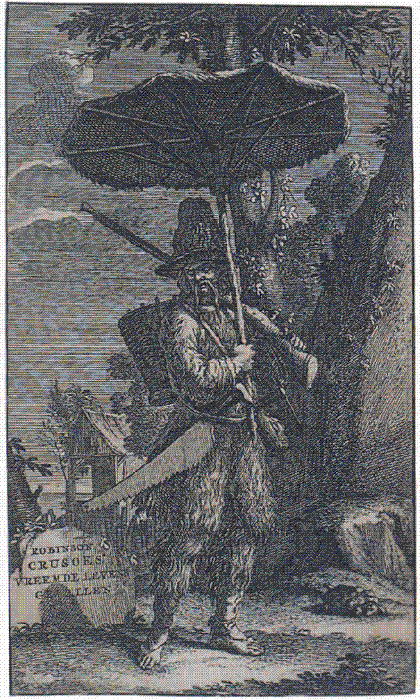
Robinson Crusoe, as portrayed by Bernard Picart in the Dutch edition of the novel.
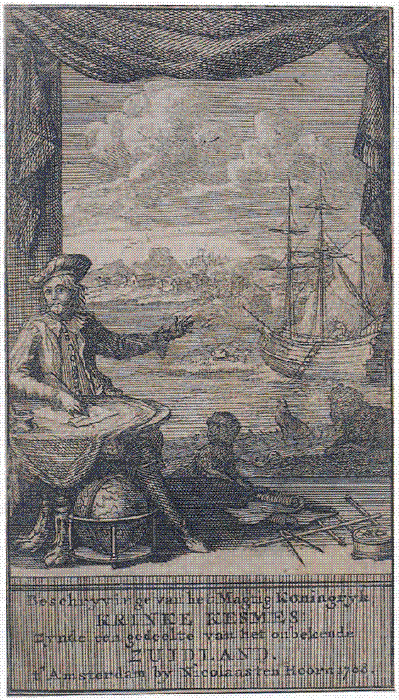
Frontispiece of The Description of the Mighty Kingdom of Krinke Kesmes (1708).
| |
| |
‘robinsonade’, a story after Robinson Crusoe. Indeed, Defoe's masterpiece had been an immediate international success, in the Low Countries as well as elsewhere. A translation appeared within a year and the prolific Dutch writer Justus van Effen made the first translation into French (Amsterdam 1720-1721). Imitations and adaptations followed in rapid order and ‘Robinsons’ emerged from many cities and provinces in several languages.
‘All adventures in which one finds unusual sea journeys, shipwrecks and a stay on remote and desert islands, one is used to call Adventures of Robinson, following the first part of Robinson Crusoe's adventures (I am not speaking of parts two and three), so beautifully written in English, and that is not a bad habit, because one knows immediately what the author's intentions are and what his work is all about.’ These are the opening lines of the anonymous author of The Adventures of the Old and the Young Robinson (Gevallen van den ouden en jongen Robinson), which appeared in print in Amsterdam in 1753, and they indicate that ‘Robinson’ had become a household name among the reading public. Yet it is not easy to define the
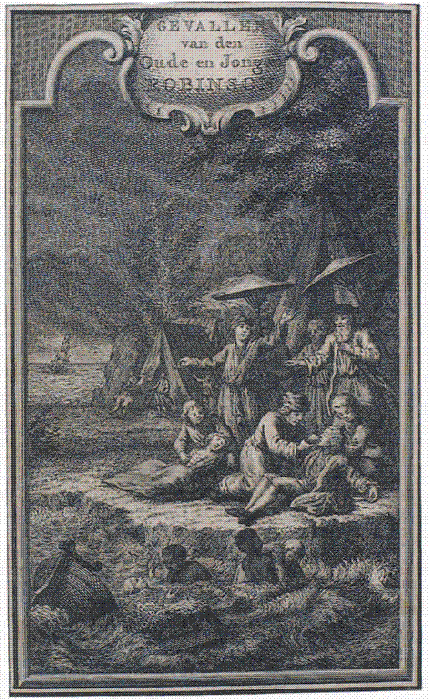
The old and young Robinsons, stranded on their island (from The Adventures of the Old and the Young Robinson, 1766 edition).
| |
| |
‘robinsonade’. The Dutch scholar W.H. Staverman, author of Robinson Crusoe in the Netherlands (Robinson Crusoe in Nederland, 1907), follows Herman Ullrich, the first Robinson-bibliographer, in including all stories that bear the name Robinson, or involve a stay on a desert island. However, many stories should be qualified as ‘adventure story’ or ‘imaginary voyage’, since shrewd publishers sometimes just changed titles, to improve their sales. The Reckless Robinson (De wispelturige Robinson) was added to The Miraculous Adventures of the Unhappy Florentine (De wonderlijke levensgevallen van den ongelukkigen Florentyner, Leiden 1730). The Memorable Voyages of Captain Robert Boyle (De gedenkwaardige reizen en zeldtzame gevallen van kapitein Robert Boyle, Amsterdam 1739) became The New English Robinson (De nieuwe Engelsche Robinson, 1761) in a second edition
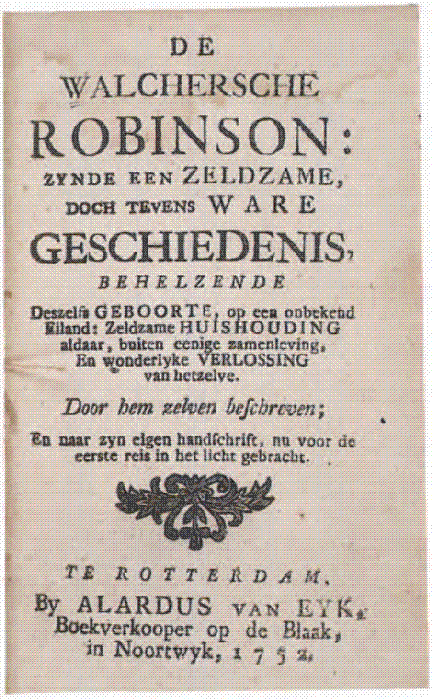
Title page of The Walcheren Robinson (1752).
and later The New and Present-Day English Robinson (De nieuwe en hedendaagsche Engelsche Robinson, Amsterdam 1794). The Ball of Fortune (De Bal van 't fortuin, Utrecht 1746) was ‘robinsonised’ to The Rare and Miraculous Case-Histories of the Brandenburg Robinson (De zonderlinge en wonderbare lotgevallen van den Brandenburgsche Robinson) four years later. Several of these stories were translated into Dutch (often from German) and one finds Robinsons from Saxony (1730), Sweden (1733), Silesia (1754) and Lebanon (1757).
Original tales in Dutch were also produced. The Holland Robinson (De Hollandsche Robinson) was published anonymously in Gouda in 1743 and tells of the amorous adventures of Mr **** in France and Portugal, his capture and enslavement by pirates (led by a Frisian (!) muslim Ismael Reys aka Ubbo Penninga). Our hero escapes, but new misfortunes land him on a desert island, from which he is liberated after twenty-eight years. He returns to the Netherlands after having spent some time with an Indian tribe in California. The similarities with Robinson Crusoe are striking, but where the Englishman remorsefully returns home, the Dutchman adds more adventures, and his stay on the island is only one of them.
A different story is found in The Walcheren Robinson (De Walchersche Robinson) - Walcheren is an island in the Dutch province of Zeeland - ‘written by himself’ and published in Amsterdam in 1752. Nineteen-year-old Sofia flees her home with her lover Eduard and they embark on a ship to the West Indies. A storm casts them up, together with a teacher, Filopater, on a desert island. A boy Robinson is born, but his parents die and Filopater is taken prisoner by pirates. A lion cares for the young boy, protects him against evil, and Robinson survives with fortune and God's providence on his side. Filopater returns to the island and takes Robinson back to Walcheren, where his grandfather's inheritance provides him with enough money to live happily ever after. Detailed geographical descriptions and the involuntary stay on the island are a few of the many similarities with Robinson Crusoe. One may also detect the influence of the Arabic novel Hay Ebn Yokdhan (1150) by Ibn Tophail, translated into Dutch in 1672. While in the Dutch story the religious reflections are definitely Dutch Reformed, both stories show that human beings, even when they grow up in solitude, can know God through nature.
Benjamin Knobbel is the hero in the anonymous story The Changeling (Het verruilde kindt, 1755), which describes the trials and tribulations of a student / teacher in England. After years of teaching young noblemen he is
| |
| |
sent on a mission to the Bermudas, but a storm wrecks the ship and he lands on an island, together with a sailor. They build a ship and leave for England, are separated, but find each other later, after it is discovered that they were exchanged as foundlings.
The title The Female Cartouche (De vrouwelijke Cartouche) - Cartouche was a famous French highwayman - suggests a different story, and indeed, rascally deeds and banditry form a substantial part of this novel, which was written by Petrus Lievens Kersteman and published in Den Bosch in 1756. Our heroine is Charlotta, who, after being chosen by pirates to be their captain, is unable to suppress a mutiny and is marooned on a desert island. There she has to stay for six years to repent of her sinful life. A Spanish captain rescues her eventually and the story ends when she enters a convent in Spain.
‘The nicest spot in Europe, and I mean Lively and Elegant the hague, was the charming place, where my eyes first saw daylight’, are the first lines of The Hague Robinson (De Haagsche Robinson, Alkmaar 1758). The anonymous writer refers with disdain to the chicaneries in Dutch politics in The Hague and he presents an alternative: the island Tirevas (an anagram of ‘veritas’?), where he had been stranded after many adventures. Here he found the ideal society, where neither money nor noble birth are important and only one God is recognised. However, after four years, he feels homesick and he travels home to write the story of his life.
Alexander, the hero of The Hague Robinson, tells his readers that he had been constrained by ‘het geval’, which in Dutch means ‘fate’ as well as ‘coincidence’, and even ‘adventure’ (as in Robinson Crusoe's case). The same combination of fortune and providence can be found in a story published a year later in Harlingen: The Miraculous Adventures of Maria Kinkons (De wonderlyke reisgevallen van Maria Kinkons). The (female?) author A.G.l.m. portrays Maria in his / her opening lines: ‘It is seldom that one sees Daughters trying to do things that fit Men and that are male enterprises; on the contrary one sees them quietly staying at home and occupying themselves with household chores. However, it was different with me, who had more interest in male than in female affairs, which sometimes brought me in the greatest difficulties, but, fortunately, I always got out of them again.’ These difficulties started when, dressed as a man, she signed on as a sailor, but was taken prisoner by Arab pirates. After escaping from slavery in a ship, she ends up on a desert island. There she is raped by a baboon and meets her man Wednesday (!). With him she travels back to the Low Countries, after having met Patagonian giants and people bearing their heads on their chests.
Another Maria, last name Ter Meetelen, had similar experiences: adventures in men's clothes, an unfortunate sea voyage and years of captivity in Northern Africa. But there is a striking difference: this Maria was for real. Archival records show that a ransom was paid by the Dutch, and that she was set free following twelve years of slavery. She returned to Amsterdam in 1743 and her story was published in Medemblik in 1748: Miraculous and Remarkable Adventures of a Twelve Year Slavery (Wonderbaarlyke en merkwaardige gevallen van een twaalfjarige slavernij, van een vroupersoon. Genaemt Maria ter Meetelen, woonagtig tot Medenblik).
The reading public must have had a difficult time separating fact from
| |
| |
fiction, certainly when novelists used proper names of ships, captains, places, countries, and assured their readers in the introduction that is was all truth: the manuscript was found, strange creatures do exist, the style is typical of a sailor's narrative (i.e. simple, the content is more important), the story is not like all those novels that give improbable events or unbelievable falsehoods etc.
Charlotte, who is the person behind The English Female Robinson (De Engelsche vrouwelijke Robinson, Amsterdam 1760), claims that she has no intention ‘to write a novel and does not want to hold up the reader with fictitious stories’. But her title is very misleading, because there is no similarity whatsoever to Defoe's work, no one in the book is called Robinson and no one even reaches an island!
Other stories also depart from the original Robinson Crusoe. Sometimes the island episode is just one among many other adventures and in a few cases the main character does land on an island, but it turns out not to be deserted at all. The island itself can remain very vague: one is bound to find a cave, albeit with great difficulty; the unmistakable pond is there and so is the lovely valley. But it is hard to find a description of the beautiful spot as poetical as in the original Robinson. The protagonists are different too: later Robinsons are seldom hard workers or handymen. Certainly, they all thank God for saving their lives, most of them find provisions from the ship, build a house, go hunting, fall ill, and leave the island better men and women. Almost as predictable are the adventures of the hero(ine) away from the island: many Robinsons are either taken by pirates or captured by the Turks with subsequent enslavement. Various stories begin with a duel over a woman, robberies by highwaymen en route, followed by a life as a sailor. Although erotic elements do appear, love or romance is dealt with in a superficial way, and Robinson Crusoe, who himself does not ever seem to miss women, could not have been the example.
It was the translator of Richardson's Clarissa (1752-1755), Johannes Stinstra, who in his introduction readily admitted that the story was fiction, but that this was balanced by its other excellences, which were true to life and which kept probability intact. The novel was slowly making its way into moral acceptance, was becoming ‘sensible’ and ‘proper’, and, unlike in the past, authors identified themselves. The voices of pedagogues and moralists began to be heard: Rousseau recommended Robinson Crusoe for his pupil Emile, and Johan Heinrich Campe's Young Robinson (Robinson der Jüngere, 1779-1780) broke all booksellers' records. The Dutch translation of this German remake of Robinson was called Manual for a Natural Education or Robinson for the Young (Handleiding tot de natuurlijke opvoeding, of Robinson Crusoe ten dienste der jeugd), and went through eight different editions between 1780 and 1836. The story is written in the form of a dialogue between a parent and his children. To make Robinson's task more difficult and to impress on children the great necessity for selfreliance, the author does not provide our hero with tools, instruments or food saved from the wreck.
Adventure stories, robinsonades and imaginary voyages did not immediately and completely vanish at the end of the eighteenth century in favour of novels with a moral lesson, suitable emotions or more sentimental selfexpression. Revolutionary times proved useful for satirical and political
| |
| |
travels to utopian islands, back to nature and away from the western world. W.E. de Perponcher's Rhapsodies or Life of Altamont (Rhapsodieën of het Leeven van Altamont, Utrecht 1775) describes a settlement on a desert island and propagates the idea that ‘the closer to nature, the closer to happiness’. Dr Schasz is the mysterious author of such exciting titles as Voyage through Wonderland (Reize door Wonderland, Amsterdam 1780), Voyage through Monkey Land and Voyage through the Land of Voluntary Slaves (Reize door het land der vrywillige slaaven, 1790). Gerrit Paape's The Happy Emigrants, or the Small Colony of the South (De gelukkige emigranten of de kleine volksplanting van het Zuiden, Antwerp 1788) discusses, in the form of an allegorical epistolary novel, political ambition, slavery, freedom of religion and ‘freedom for women to show their emotions’. Similar feelings can be found in The Colonists (De kolonisten, Amsterdam 1826) and The Frisian Robinson Crusoe (De Friesche Robinson Crusoe, Sneek 1834). However, when Willem Bilderdijk sent his characters up, up and away in a balloon in his Remarkable Air Voyage and Planet Discovery (Kort verhaal van eene aanmerkelijke luchtreis en nieuwe

A Robinson Crusoe board game in German, French, Italian and Dutch (Germany, c. 1840).
| |
| |
planeetontdekking, 1813), the heyday of robinsonades and imaginary voyages was over. Readers had to wait for Jules Verne to pick up where his predecessors left off.
The story of the Dutch robinsonades is not yet complete: we lack a comprehensive bibliography and a clear picture of authors and reading public. However, it demonstrates that the presence of Dutchmen in colonial conquests around the globe was reflected in a literature not yet carved into modern literary conventions. It also shows how closely interconnected the North-West European literature of the time was. In addition to the interesting encounters of western-minded man (and woman) with other races and cultures, it has all the excitement of adventure and imagination in it. Prose had become an instrument for launching ideas, aggressive opinions and powerful fantasies. Travel in the eighteenth century was not just a tourist's adventure with many inconveniences; it was still in an exploratory phase in a world that had not yet given up all its secrets. Together these elements formed a strong formula for success.
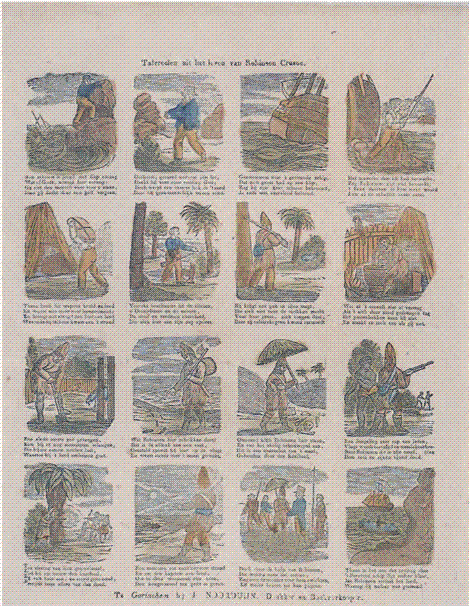
Scenes from the Life of Robinson Crusoe, a catchpenny print (wood engraging, probably by Alexander Cranendoncq, Gorinchem, c. 1820).
| |
| |
Robinson Crusoe stands for the human being as economic individualist, looking for the basics in an unspoiled world, investigating the essentials of religion and relying on his energy, determination and ingenuity. He has survived the ages and crossed geographical and language boundaries, in the most imaginative froms and shapes: in theatre, cartoons, films, advertising and business (in the fifties Dutch shoe shops sold Robinson sandals). Even though the original three-volume book is seldom read, young and old readers still share Robinson's despair during his lonely first days, or his fear when seeing the footprint in the sand, and many people have fantasised about life on a desert island, with their ten favourite books or pieces of music.
And what happened in Monkey Land, the story I mentioned at the beginning? The monkeys all came together in one grandiose effort to become humans. They chopped off their tails and bled to death. Fortunately, dear readers, this all happened in a dream.
ton j. broos
| |
Further reading
| broos, ton, ‘Robinson Crusoe in the Low Countries’, Dutch Crossing, 23, 1984, pp. 32-45. |
| broos, ton (ed.), De wonderlyke reisgevallen van Maria Kinkons... door A.G.l.m.. Amsterdam, 1986. |
| broos, ton, anton bossers and jelle kingma (eds.), Robinson in the Old and New Worlds. The Hague, 1992. |
| broos, ton, ‘De oudste neerlandicus extra muros: Nederlands op Krinke Kesmes en andere merkwaardige gevallen’, Neerlandica extra muros, xxxi, 2 (May 1993), pp. 20-31. |
| buijnsters, p.j., ‘Imaginaire reisverhalen in Nederland gedurende de 18e eeuw’, in: Nederlandse literatuur van de achttiende eeuw. Veertien verkenningen. Utrecht, 1984, pp. 7-35. |
| dekker, rudolf m. and lotte c. van de pol, The Tradition of Female Transvestism in Early Modern Europe. New York, 1989. |
| gove, p.b., The Imaginary Voyage in Prose Fiction. London, 1961. |
| green, martin, The Robinson Crusoe Story. London, 1990. |
| hubbard, l.l., A Dutch Source for Robinson Crusoe. The Narrative of the El-Ho ‘Sjouke Gabbes’ (also known as Henrich Texel). An Episode from the Description of the Mighty Kingdom of Krinke Kesmes, Et cetera by Hendrik Smeeks 1708 - translated from the Dutch and compared with the story of Robinson Crusoe. Ann Arbor / The Hague, 1921. |
| rogers, pat, Robinson Crusoe. London, 1979. |
| smeeks, hendrik, Beschryvinge van het magtig koningryk Krinke Kesmes (ed. P.J. Buijnsters). Zutphen, 1976. |
| staverman, w.h., Robinson Crusoe in Nederland. Groningen, 1907. |
| ullrich, herman, Robinson und die Robinsonaden. Bibliographie, Geschichte, Kritik. Weimar, 1898. |
|
|